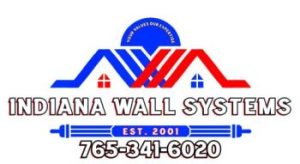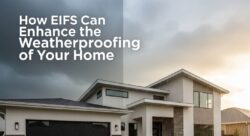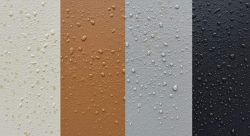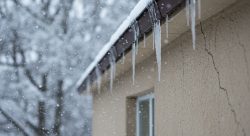Don’t Let Spring Showers Soak Your Savings — Use This Expert Checklist to Catch EIFS Issues Early and Protect Your Indiana Home All Season Long
Spring brings rain and temperature swings that can damage your home’s exterior walls. EIFS (Exterior Insulation and Finish System) needs regular checks to prevent costly water damage and mold growth.
Our Spring EIFS Checklist will help you spot small problems before they turn into major repairs. Get ready to protect your investment and boost your home’s energy efficiency.
Key Takeaways
- Regular EIFS inspections prevent small issues from becoming costly water damage and mold problems.
- Spring is ideal for EIFS checks after winter’s freeze-thaw cycles, which can create cracks in your exterior walls.
- Focus on four key areas: caulking integrity, flashing systems, moisture barriers, and seals around windows and doors.
- Clear all plants, furniture and debris at least 3 feet from your walls before inspection to spot early damage signs.
- Certified EIFS inspectors have special tools to detect hidden moisture problems that homeowners often miss.
Understanding EIFS
EIFS systems protect your home with layers of insulation and decorative finishes. These wall coverings combine foam boards, mesh, and special coatings to create a weather-resistant shield for your Indiana home.
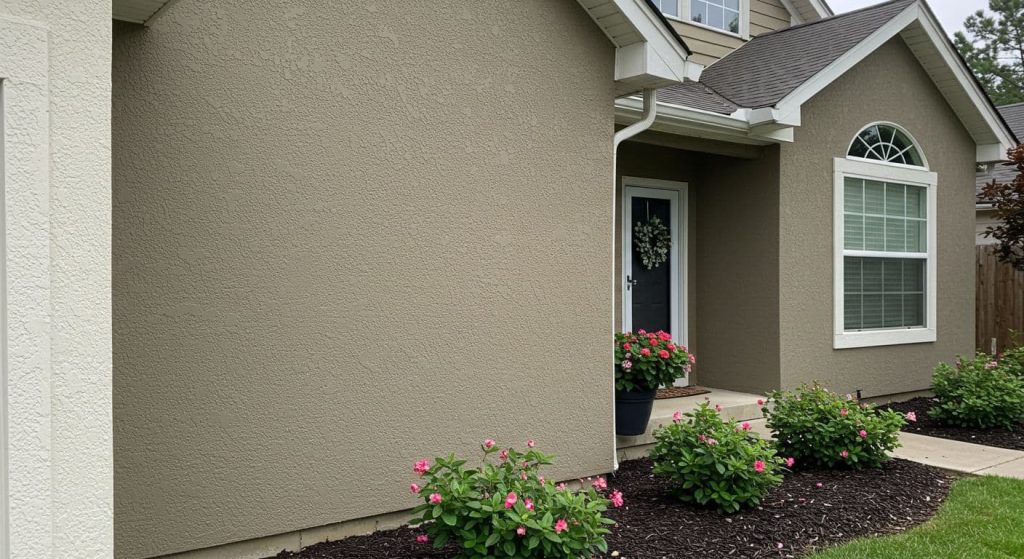
What is EIFS?
EIFS stands for Exterior Insulation and Finish System. This wall covering acts like a blanket for your home, adding both beauty and function to your exterior walls. The system uses several layers that work together: foam insulation board forms the base, followed by a reinforced coat with protective mesh, and topped with a durable finish coat.
Unlike traditional siding options, EIFS creates a seamless look while providing excellent insulation.
A well-maintained EIFS system enhances curb appeal and serves as your home’s first line of defense against Indiana’s changing seasons.
Many Indiana homeowners choose this exterior cladding system because it offers major energy savings. The foam layer stops heat from escaping in winter and keeps cool air inside during hot summer months.
Modern EIFS products include drainage planes that help water flow away from your walls, preventing moisture problems that could lead to mold growth and rot.
How EIFS Works
EIFS consists of several layers that work together as a complete wall system. The base layer attaches to your home’s exterior wall, followed by insulation boards made from polystyrene foam.
These boards get covered with a special mesh that adds strength. Next comes a base coat that protects against impacts, topped with a finish coat that gives your home its color and texture.
This multi-layer design creates a thermal blanket around your house that blocks heat transfer through the walls.
The magic of EIFS lies in its ability to reduce energy costs while maintaining curb appeal. The exterior insulation finishing system traps air in tiny pockets within the foam boards, creating an effective barrier against outside temperatures.
This barrier stops heat from escaping in winter and blocks hot air from entering in summer. Modern EIFS systems include drainage planes that channel away any moisture that might get behind the surface.
This drainage feature protects your walls from water damage and helps maintain the system’s insulating properties for years.
Why Spring is the Perfect Time for an EIFS Inspection
Spring offers ideal conditions for EIFS inspections after winter’s harsh effects on your home exterior. The freeze-thaw cycles common in Indiana can stress your EIFS cladding, creating small cracks that might grow larger if ignored.
Milder temperatures allow certified inspectors to spot moisture problems in EIFS before summer storms arrive, giving you time to schedule necessary repairs.
Regular EIFS inspections help assess energy efficiency and identify small issues before they become major expenses. Indiana Wall Systems provides professional evaluations with certified experts who understand local building codes and seasonal maintenance needs.
These timely checks protect your property value and ensure your exterior walls remain in top condition, helping your heating and cooling systems work better throughout the year.
Preparing for an EIFS Inspection
Getting your home ready for an EIFS inspection takes some simple steps that protect your investment. Clear access to your exterior walls and a basic visual check can help you spot trouble spots before they grow into major issues.
Clear the area around exterior walls
Before your spring EIFS inspection, remove all objects touching your exterior walls. Plants, furniture, toys, and garden tools must be moved at least 3 feet away from the house. This creates clear access for proper inspection of your EIFS surfaces.
Trimming back shrubs and vines helps too – vegetation against walls can trap moisture and damage your EIFS system over time.
A clear perimeter around your home isn’t just for inspections—it’s your first line of defense against moisture damage.
Clearing the area also lets you spot early signs of trouble like stains, cracks, or pest damage. Look for dirt buildup at the base of walls that might block drainage paths. Good drainage plays a key role in EIFS performance, so remove any soil or mulch that touches the bottom edge of your siding.
This simple step helps stop water from getting trapped and prevents mold growth – a common issue with older EIFS installations.
Check for visible damage or discoloration
After clearing vegetation and debris from your exterior walls, inspect your EIFS surface for signs of trouble. Look closely at the entire wall system for cracks, chips, or areas where the finish appears damaged.
Pay special attention to spots with unusual stains or discoloration, as these often signal moisture problems beneath the surface. Dark patches may indicate mold growth, while yellowish stains might suggest water intrusion issues.
Document all visible damage with photos for your records. Mark areas of concern on a simple diagram of your home to track problems over time. This visual record helps track if small issues are growing worse and serves as proof if you need to file insurance claims.
Catching these warning signs early can prevent costly EIFS repairs down the road and maintain your home’s structural integrity and energy efficiency.
Ensure proper drainage around the foundation
Proper drainage around your foundation plays a vital role in EIFS protection. Water must flow away from your home to prevent moisture damage that can ruin your exterior walls. Clear all gutters, downspouts, and drainage channels of leaves and debris that block water flow.
The EIFS inspection checklist always includes checking these drainage systems because they directly impact your wall system’s health.
Your home’s foundation needs at least a six-inch clearance between the ground and where the EIFS begins. This gap helps water drain properly instead of seeping into the system. Many EIFS issues start with poor drainage that allows water to collect against walls.
Fixing drainage problems now saves money in the long run by avoiding costly repairs to your exterior finish systems. Next, let’s look at the key areas you should inspect during your EIFS check.
Key Areas to Inspect During an EIFS Check
Your spring EIFS check must focus on four critical areas that often show the first signs of trouble – and finding problems early can save you thousands in repair costs.
Caulking and sealant integrity
Caulking and sealants form the first line of defense for your EIFS system. These materials seal joints around windows, doors, and other wall penetrations to block water from getting behind your exterior walls.
Over time, these sealants can crack, shrink, or pull away from surfaces due to Indiana’s harsh weather cycles. A proper spring check should include pressing gently on all sealant joints to test for firmness and adhesion.
Damaged sealants need quick attention before spring rains cause bigger problems. Look for gaps, cracks, or spots where the caulk has changed color or texture. Fresh sealant applied to clean, dry surfaces will help maintain your EIFS system’s moisture barrier.
This simple maintenance step can prevent costly repairs and extend the life of your exterior finish for years with proper care.
Flashing and drainage systems
While proper caulking forms your first defense line, flashing and drainage systems work as your EIFS’s critical backup plan. These systems direct water away from your walls and prevent moisture damage.
Flashing—those metal or plastic strips installed around windows, doors, and wall junctions—creates paths for water to flow away from your home rather than seeping inside. Every Indiana homeowner should check these areas during spring inspections to spot any rust, gaps, or improper installations.
Drainage systems manage any water that might get behind your EIFS coating. These pathways allow moisture to escape before causing rot or mold growth. Regular checks help find blockages from debris or damage that could trap water against your walls.
Quick fixes to flashing and drainage issues now can save you from costly repairs later. Proper maintenance of these systems extends your EIFS lifespan and keeps your home’s exterior walls in top shape through Indiana’s spring storms and summer humidity.
Moisture barriers
Moisture barriers form a critical shield in your EIFS system. These waterproof layers sit behind the foam insulation and stop water from reaching your home’s structure. A proper barrier must remain intact to prevent mold, rot, and costly structural damage.
During spring inspections, check for tears or gaps in this protective layer, especially near windows, doors, and other wall penetrations. Specialized moisture detection tools can spot hidden water issues before they cause serious harm.
Your moisture barrier needs extra attention in Indiana’s climate with its heavy spring rains. Look for signs of water staining on interior walls that might signal barrier failure. The barrier should connect properly with flashing systems to direct water away from your home.
Proper EIFS maintenance includes making sure this invisible but essential layer stays in good shape to protect your property value and prevent expensive repairs down the road.
Windows and doors
After checking moisture barriers, pay close attention to windows and doors in your EIFS system. These openings create natural breaks in your exterior walls where water can sneak in.
Proper flashing and caulking around windows and doors stops moisture from getting behind your EIFS. Examine seal condition and check for water intrusion signs like staining, warping, or soft spots near frames.
Look for cracks in the caulking that need fresh sealant every six months during spring and fall inspections. Small gaps can let water seep in and cause big damage over time. Clean these areas with mild soap and water to remove dirt that might hide problems.
Certified EIFS professionals can spot trouble areas you might miss during your regular checks.
Common EIFS Problems to Look For
Spring weather can expose hidden EIFS damage that formed during winter months. Watch for cracks, peeling, and dark spots which signal moisture has breached your home’s exterior system.
Mold growth and rot
Mold and rot create serious problems for EIFS-clad homes in Indiana. Black or green spots on your exterior walls signal trouble beneath the surface. These fungi thrive in damp conditions, often starting behind the EIFS where moisture gets trapped.
Our inspections regularly detect mildew growth that homeowners never noticed. Left unchecked, this moisture damage weakens your wall structure and can lead to expensive repairs. The wood framing behind your EIFS becomes soft and crumbly as rot spreads, putting your home’s structural integrity at risk.
Regular moisture testing helps catch these issues early before they grow into big problems. Look for discoloration, musty odors, or bubbling in your EIFS finish – these are warning signs that need immediate attention.
Proper eifs installation with working drainage systems prevents water from getting trapped. Cracks in your exterior caulking create perfect entry points for water that feeds fungal growth.
Your next inspection should focus on checking for signs of water damage around windows and doors where leaks commonly occur.
Cracks or chips in the finish
Cracks or chips in your EIFS finish create entry points for moisture to seep into your wall system. These small breaks in the surface might start tiny but grow larger through Indiana’s freeze-thaw cycles.
Regular checks for these surface damages should top your spring maintenance list. Look closely at areas around windows, doors, and near the foundation where stress points often develop.
Even hairline cracks need prompt attention before spring rains turn minor issues into major repairs.
Proper repair of damaged EIFS finish requires specific materials made for these systems. Small cracks can often be sealed with quality caulking designed for exterior use, while larger chips may need professional patching.
The right EIFS experts use better materials that last longer and match your existing finish. Next on your inspection list should be checking for signs of water penetration issues that often follow surface damage.
Water penetration issues
Water penetration ranks as the #1 enemy of EIFS systems in Indiana homes. Rain seeps through tiny cracks and damaged sealants, causing rot, mold, and structural damage behind your walls.
Most homeowners don’t spot these issues until serious damage occurs. Look for water stains on interior walls, bubbling paint, or musty odors as early warning signs. Small openings around windows, doors, and utility penetrations create perfect entry points for moisture to attack your home’s structure.
Regular checks of your drainage systems help prevent costly repairs. Make sure downspouts direct water away from your foundation and that ground slopes away from your home. Proper flashing installation around windows and doors blocks water from entering wall cavities.
Next on our checklist, we’ll explore how pest damage can compromise your EIFS system.
Pest damage
Pests pose a serious threat to EIFS systems on Indiana homes. Insects and rodents often create nests in cracks or damaged areas of your exterior walls, making small problems much worse.
Regular EIFS inspections help spot early signs of pest activity before major damage occurs. Mice, ants, and termites can chew through weak spots in your home’s exterior, especially where moisture has already compromised the system.
Certified EIFS inspectors look for tiny holes, unusual markings, and damaged seals that might indicate pest problems. They focus on areas around windows, doors, and the foundation where pests commonly enter.
Proper documentation of any visible damage helps track potential pest issues over time. After identifying pest-related problems, you’ll need to address both the pests and repair the damaged EIFS to prevent future infestations.
Let’s explore how to choose a qualified inspector for your EIFS system.
EIFS Inspection Checklist for Homeowners
Spring offers the perfect time to check your home’s EIFS system for damage after winter. This simple checklist helps ensure your EIFS stays in top shape and continues to protect your Indiana home from the elements.
- Inspect all caulking around windows, doors, and joints for cracks or gaps that need fresh sealant.
- Look for any cracks or chips in the EIFS finish coat, especially near high-traffic areas and corners.
- Check for stains, discoloration, or bulging areas that might signal water damage beneath the surface.
- Test drainage systems by making sure water flows away from your foundation after spring rains.
- Examine all flashing around windows, doors, and roof edges to confirm proper installation.
- Clean EIFS surfaces with mild soap and water to remove dirt, pollen, and mildew buildup.
- Document any visible damage with photos for your records and insurance purposes.
- Tap gently on suspect areas – hollow sounds may indicate separation of EIFS layers.
- Measure moisture levels with a moisture meter if you have access to one.
- Verify that sprinklers direct water away from EIFS walls to prevent excess moisture exposure.
- Search for signs of pest activity, especially near ground level where insects might enter.
- Inspect roof gutters and downspouts to ensure proper function and prevent water overflow onto EIFS.
- Check that landscaping maintains proper clearance from EIFS surfaces (at least 8 inches).
- Examine all penetrations through EIFS (pipes, vents, fixtures) for proper sealing.
- Prepare questions about any concerns for your certified EIFS inspector based on your findings.
Importance of Regular EIFS Inspections and Repair
Regular EIFS inspections protect your home from hidden damage that can lead to costly repairs. Most problems start small – a tiny crack or loose sealant – but grow into major issues if left unchecked.
Your EIFS system needs yearly checks to spot these early warning signs. Proper maintenance ensures structural integrity and boosts energy efficiency, keeping heating and cooling costs lower throughout Indiana’s changing seasons.
Moisture detection during inspections prevents mold growth and rot, which can harm both your home’s structure and your family’s health.
Professional EIFS care extends the lifespan of your exterior wall system and maintains your property value. A certified inspector will examine caulking, flashing, and drainage systems that stop water from getting trapped behind the finish.
They use special tools like thermal imaging to find hidden moisture problems before visible damage appears. Small repairs made right away cost much less than complete system replacement.
Green EIFS options now offer better insulation with eco-friendly materials, making regular upkeep even more important for modern homes focused on environmental sustainability.
How to Choose a Certified EIFS Inspector
Finding a skilled EIFS inspector requires checking for proper credentials, industry experience, and knowledge of local building standards – read on to learn how to spot a true professional who can protect your Indiana home from costly damage.
Look for certifications and experience
Hiring a certified EIFS inspector saves you time and money in the long run. The National Association of Home Builders (NAHB) offers specific credentials for EIFS specialists that prove their expertise.
Ask potential inspectors to show their NAHB certification card or number before you hire them. A qualified inspector should have at least five years of hands-on experience with exterior insulation systems in Indiana homes.
They must understand how freeze-thaw cycles affect EIFS performance and know proper thermal imaging inspection techniques.
Check the inspector’s track record with other property owners in your area. Professional EIFS experts will gladly provide references from past clients with similar homes. They should also stay current on building codes and regulations that apply to Indiana’s unique climate.
The best inspectors can spot early signs of EIFS damage that untrained eyes might miss. Their reports will include detailed photos and clear recommendations for any needed repairs or preventative EIFS care.
Ask for references
Always ask EIFS inspectors for a list of past clients. Good inspectors will gladly share names of homeowners they’ve helped in Indiana. Call these references to learn about the inspector’s work quality and professionalism.
Did they show up on time? Were they thorough? Did they explain problems clearly? References give you real feedback about what to expect. The best EIFS professionals build their reputation through satisfied customers who are happy to vouch for their skills.
Getting references helps you avoid costly mistakes when hiring someone to check your home’s exterior walls. Look for inspectors who have worked on homes similar to yours in your area.
This ensures they understand local climate issues that affect EIFS performance. Many quality inspectors keep before-and-after photos of their work, which can show you their attention to detail.
This simple step of checking references can save you from hiring someone who might miss critical damage to your EIFS system.
Verify knowledge of Indiana building codes
After checking references, make sure your inspector knows Indiana building codes. Indiana has specific rules for EIFS installations that address our unique weather patterns. A qualified inspector must understand these local regulations to spot code violations that could lead to water damage or energy loss.
The inspector should explain how your home meets or fails these standards in clear terms.
Local code knowledge matters because Indiana faces harsh freeze-thaw cycles that stress exterior systems. Your inspector needs extensive EIFS inspection experience to recognize when installations don’t meet Indiana’s requirements for moisture barriers and drainage systems.
This expertise helps protect your home from damage while maintaining its value and energy efficiency.
Post-Inspection Steps
After your EIFS check, you’ll need to take proper steps to fix any issues found. Your inspection report will point out problems that need quick action to protect your home from moisture damage.
Understanding the inspection report
Your EIFS inspection report contains vital details about your home’s exterior condition. Each report lists problem areas, damage severity, and repair needs in clear sections. Look for moisture readings, which show if water has seeped behind your walls.
The report will include photos of trouble spots and explain how urgent each repair is. Read the entire report carefully to grasp all issues found during the check-up. Most reports end with next steps and cost estimates for fixes your home needs.
Professional inspectors use color codes or number scales to rank problems from minor to major. These rankings help you decide which repairs to tackle first. If you spot terms you don’t understand, call your inspector for simple explanations.
Many homeowners miss important details by skimming reports too quickly. Taking time to review each section protects your investment and prevents small issues from growing into costly repairs.
Scheduling necessary repairs
Once you have your inspection report in hand, the next step is to schedule needed repairs based on their severity. Not all EIFS issues require immediate attention, but some do demand quick action to prevent further damage.
Create a repair strategy that lists specific actions, clear timelines, and budget estimates for each problem. Mark urgent repairs that affect your home’s structure or could lead to water damage.
Many EIFS contractors in Indiana get booked quickly during spring, so call for appointments as soon as possible after your inspection.
For best results, group similar repair tasks together to save on service calls and labor costs. Ask your EIFS repair professional about seasonal maintenance packages that might include both immediate fixes and preventive work.
Most quality contractors will help you develop a repair schedule that fits your budget while tackling the most critical issues first. This approach keeps your EIFS system in top shape and extends its lifespan, making your home safer and more energy-efficient through all seasons.
Preventive maintenance recommendations
Regular upkeep of your EIFS system saves money and prevents major repairs. We suggest applying a clear sealer to your exterior walls every three years to block moisture. This simple step extends your EIFS lifespan by up to 30%.
Check all caulking twice yearly and replace any cracked or peeling sections right away. Keep detailed records of all inspections and repairs for future reference. A proper maintenance plan should include gutter cleaning each spring to prevent water from splashing onto your EIFS surfaces.
Most Indiana homes benefit from a professional EIFS cleaning with mild soap and soft brushes once per year to remove dirt that can trap moisture against walls.
Tips for Maintaining EIFS Between Inspections
Regular upkeep of your EIFS system prevents costly repairs and extends its life. Simple tasks like cleaning with mild soap and checking for cracks can protect your home from moisture damage.
Regular cleaning with mild soap and water
Your EIFS exterior needs proper cleaning twice a year with mild detergent and water. This simple task removes dirt, pollen, and other debris that can harm your wall system over time.
Mix a gentle soap with warm water and apply it with a soft cloth or sponge to keep your exterior walls looking fresh. Harsh chemicals and abrasive tools will damage the finish coat, so avoid them at all costs.
Never use pressure washers on EIFS surfaces – they force water into tiny cracks and cause major moisture problems.
The right cleaning routine extends your EIFS lifespan and keeps your home’s exterior looking great through Indiana’s changing seasons. Next, we’ll explore why checking caulking and sealants every six months helps prevent costly water damage to your home’s exterior walls.
Inspect caulking and sealants every six months
After cleaning your EIFS walls with mild soap, turn your attention to the critical sealing points. Checking your caulking and sealants twice yearly helps catch small issues before they cause big problems.
These flexible materials form vital barriers around windows, doors, and joints where water might enter. Over time, Indiana’s freeze-thaw cycles can cause these seals to crack, shrink, or pull away from surfaces.
Look for gaps, cracks, or discoloration in all sealed areas during your inspection. Press gently on suspect areas to check for softness or movement that signals failure. Regular sealant checks rank among the most important EIFS maintenance tasks homeowners can perform.
Proper caulking inspection prevents moisture from entering your wall system and causing rot or mold growth. Mark your calendar for spring and fall reviews to keep your home safe from water damage and maintain your EIFS performance for years to come.
Address minor issues before they worsen
Small EIFS problems can quickly turn into costly repairs if left alone. Tiny cracks might seem harmless but allow moisture to seep in, creating perfect spots for mold growth. Check your exterior walls monthly for hairline cracks, loose caulking, or small chips in the finish.
Mark these spots with tape and fix them within a week. Regular checks help maintain your EIFS system and stop damage from spreading.
Fixing minor issues saves money and extends your EIFS lifespan. A simple caulk touch-up costs just a few dollars, while major water damage repairs can run thousands. Indiana’s freeze-thaw cycles make small cracks expand quickly during winter-to-spring transitions.
Use proper EIFS-specific products for repairs – standard house caulk won’t provide the right protection. Seasonal maintenance tips include gentle cleaning with mild soap and checking drainage paths around your foundation.
Best Practices for Cleaning and Maintaining EIFS
Proper EIFS care starts with gentle cleaning methods. Mix mild soap with water and use a soft brush to remove dirt from your walls twice yearly. Indiana Wall Systems experts suggest avoiding pressure washers, which can force water behind the surface and cause damage.
Regular cleaning prevents mold growth and keeps your home looking fresh while extending the life of your EIFS coatings.
Check all sealants around windows, doors, and joints every spring. Replace cracked or peeling caulk right away to stop moisture from getting inside. Touch up small chips or cracks in the finish coat before they grow larger.
This simple step helps your EIFS last longer through Indiana’s freeze-thaw cycles and spring storms. Quality assurance in maintenance leads to fewer repairs and better insulation performance for your home.
Benefits of Regular EIFS Inspections
Regular EIFS inspections save you money by catching small issues before they turn into major repairs. These checks help your home stay energy-efficient and maintain its value in Indiana’s changing seasons.
Protects exterior walls from damage
Regular EIFS checks shield your home’s exterior walls from costly damage. EIFS systems create a protective barrier that fights against cracks, water intrusion, and unsightly discoloration.
This barrier works hard through Indiana’s harsh weather cycles, keeping your walls safe from rain, snow, and summer heat. The outer layer acts as armor for your home, preventing moisture from seeping into the structure where it could cause rot or mold growth.
EIFS solutions offer superior protection compared to traditional stucco alternatives. The multi-layered system includes special waterproofing techniques that extend wall life and maintain your home’s value.
Proper flashing checks during inspections catch small issues before they grow into major problems. Your EIFS needs regular attention to perform at its best, especially after freeze-thaw cycles that can stress exterior surfaces.
Modern eco-friendly EIFS provides this protection while also helping with energy efficiency.
Enhances energy efficiency
EIFS adds a powerful layer of insulation to your home’s exterior walls. This extra barrier stops heat from escaping during cold Indiana winters and blocks hot air from entering during summer months.
Your heating and cooling systems won’t need to work as hard, which leads to lower energy bills year-round. Many homeowners see a 20-30% drop in energy costs after proper EIFS installation and maintenance.
Regular EIFS inspections help maintain this energy-saving performance. Small cracks or damage can reduce insulation effectiveness if left unrepaired. A spring check ensures your home stays energy-efficient through all seasons.
The system works best when all components remain intact – from the base layer to the finish coat. Proper care of your EIFS walls protects both your home and your wallet from unnecessary energy waste.
Extends the lifespan of the system
Beyond saving energy, proper EIFS care makes your home’s exterior last much longer. Regular inspections catch small problems before they turn into costly repairs. Fixing minor cracks and sealant issues right away stops moisture from getting trapped inside the system.
This proactive approach prevents damage to the underlying materials and structure.
Your EIFS can last 20-30 years with proper care instead of needing replacement after just 10-15 years. Think of it like changing your car’s oil regularly – simple maintenance now saves big money later.
The Indiana freeze-thaw cycles put extra stress on exterior walls, making regular checks even more important for local homeowners. Products that last longer around your home stop heat loss and protect your investment for decades.
Maintains property value
A well-maintained EIFS system extends your home’s lifespan and boosts your property value too. Homes with properly cared-for EIFS attract higher resale prices in the Indiana market.
Regular inspections prove to potential buyers that you’ve protected your investment. The exterior condition makes a strong first impression during home showings.
Proper EIFS care prevents costly damage that could lower your home’s worth. Moisture issues, if left unchecked, can lead to structural problems that scare away buyers. Smart homeowners document their EIFS maintenance history as proof of diligent upkeep.
This documentation serves as a valuable selling point that justifies asking for top dollar when it’s time to sell your Indiana property.
Indiana Climate Considerations for EIFS Care
Indiana’s harsh freeze-thaw cycles and spring storms can damage your EIFS system if not properly maintained – learn how to protect your home’s exterior with our complete guide to weather-proofing techniques that extend your wall system’s life.
Freeze-thaw cycles and their impact
Indiana winters create tough challenges for EIFS systems on homes. As temperatures swing between freezing and thawing, your exterior walls expand and contract, leading to cracks where moisture can sneak in.
These cracks might start small but grow larger with each cycle, putting your home’s structure at risk. Many homeowners don’t notice these issues until spring reveals water damage or mold growth inside walls.
Regular EIFS checks help spot freeze-thaw damage before it worsens. Certified inspectors use moisture meters and thermal imaging to find hidden wet spots that formed during winter’s harsh cycles.
The energy efficiency of your home depends on intact EIFS – even small cracks from freeze-thaw stress can cut your insulation value and raise heating bills. Addressing these problems quickly protects both your wall system and your wallet from bigger repairs later.
Preparing for spring storms
Spring storms can damage your EIFS if you don’t prepare properly. Start by checking all caulking and sealants around windows, doors, and joints for cracks or gaps. These weak spots let water seep in during heavy rains, causing hidden moisture problems.
Clean your EIFS walls with mild soap and water to spot any cracks or chips that need repair before storm season hits. Good drainage around your home stops water from pooling near the foundation, which helps protect your EIFS system during downpours.
Regular EIFS inspections help maintain both structural strength and energy efficiency during storm season. Indiana homeowners face unique challenges with freeze-thaw cycles that can stress exterior walls.
Document any visible damage with photos to share with your inspector. This step gives them a clear picture of problem areas that need extra attention. A certified EIFS inspector will check for moisture issues, delamination, and mold growth that might worsen during severe weather.
Next, we’ll explore the key areas you should focus on during your EIFS inspection.
Conclusion
Your EIFS system needs regular care to protect your Indiana home from weather damage. A spring inspection finds small problems before they become costly repairs. Your checklist should include checking seals, looking for cracks, and making sure water drains properly.
Professional inspectors bring tools and skills that spot hidden issues you might miss. Taking care of your EIFS now saves money on energy bills and keeps your home looking great for years to come.
FAQs
What should I check on my EIFS walls after winter?
Look for cracks or damage on your existing EIFS that might have happened during winter. The newest EIFS systems are tough, but older ones need careful checks. Wash your EIFS walls gently to remove dirt and check for any spots that need repair.
How does EIFS help with energy costs in spring?
EIFS offers better insulation than many other wall systems. It creates a barrier around your home that stops heat from escaping, cutting your energy bills. Spring is a perfect time for energy audits to see if your EIFS is working at peak performance.
When is it time for an EIFS upgrade?
If your EIFS is over 15 years old or shows signs of wear, spring may be the right time for an upgrade. Top EIFS makers now offer products with better damage prevention strategies and longer EIFS longevity.
What maintenance does EIFS need in spring?
Regular cleaning and a building envelope inspection are must-dos for residential EIFS care. Check seals around windows and doors where water might get in. EIFS can reduce energy costs, but only when properly maintained.
How can I prep my EIFS for spring storms?
Make sure all seals are tight and drainage systems are clear. The EIFS industry has developed special products made for EIFS storm protection. Check that your system includes proper flashing and water management features.
What trends in EIFS technology should I know about?
The latest EIFS technology includes better water resistance and more eco-friendly materials. EIFS is known for durability, but newer systems also help cut down on harmful emissions. These improvements make every project more efficient and longer-lasting.
